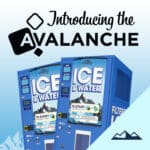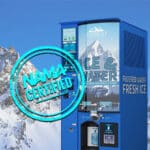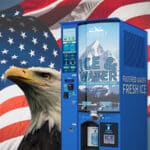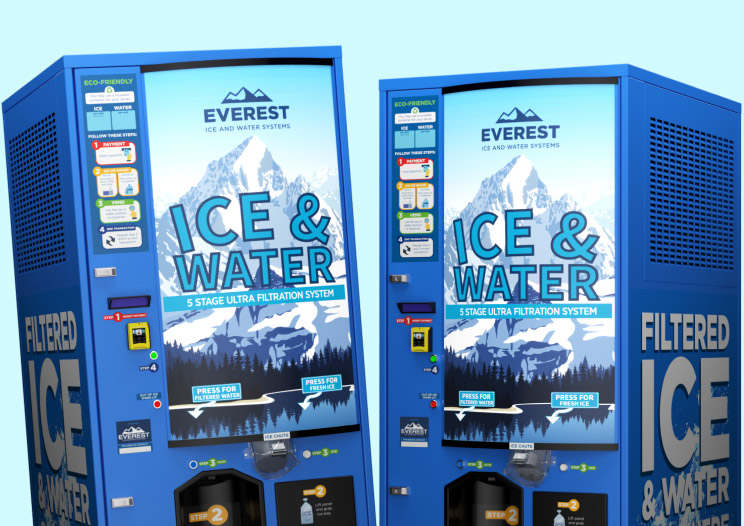Earth Day: Why Ice Matters

This year’s Earth Day theme is “Invest in Our Planet.” It’s all about individuals and businesses alike taking collective action and accountability in order to improve sustainability efforts and make a change.
So where does ice fit into this effort?
This is at the heart of our mission at Everest. Not only is it important to provide communities with access to sanitary, affordable ice and water, but we aim to replace the outdated services of the past in order to reduce the harmful impacts of the ice delivery supply chain.
In the peak season, popular ice delivery companies can have dozens of drivers from numerous manufacturing plants and distribution hubs delivering thousands of bags of ice PER TRUCK every day. That’s a huge impact on your carbon footprint, not to mention the waste of plastic, water, and electricity.
Take a look at the ways you (AND your customers) can be more eco-friendly in the way you buy and sell ice:
Earth Day: The Carbon Cost of Delivery
The ice delivery supply chain isn’t just costly, unreliable, and inconvenient – it also contributes a significant carbon footprint. Transportation accounted for 27% of greenhouse gas emissions in 2020 – more than any other sector, according to the EPA.
Emissions from Medium- and Heavy-Duty Trucks increased by 83.5% from 1990 to 2020. Refrigerated trucks have even higher CO2 emissions because of the need for constant temperature control.
So: how much could you reduce your carbon footprint by eliminating just one refrigerated delivery truck a year? The answer drastically varies depending on a number of factors, including distributor, season, location, equipment, number of stops, distance to be traveled, and more. You could remove anywhere from 2 to upwards of 40 metric tons of carbon dioxide emissions per year – and that’s just one truck.
Despite the variables, there’s one constant: a guaranteed reduction in greenhouse gas emissions.
Ice, Water, and Single-Use Plastics
Approximately 91% of plastic is not recycled. Roughly half of the plastic produced globally in a year is intended for single-use. So much plastic is produced on this Earth that in a single year that it weighs almost the same as the entire weight of humanity. So how does ice and water come into play?
- Bottled Water: Americans purchase around 50 billion water bottles every year at an average of 13 bottles monthly for every person in the U.S. An individual switching to reusable water bottles could eliminate an average of 156 plastic bottles annually – so imagine what a store owner could eliminate by selling bulk filtered water as an alternative (AND for a lower cost than one single plastic bottle of water?)
- Plastic Bags: Five trillion plastic bags are produced globally every year. Of these, Americans are throwing 100 billion bags away – equal to dumping 12 million barrels of crude oil. 40% of ice customers use coolers over bags, which means they get wasted immediately upon purchase. For a retail location that sells 25 bags of ice a day, switching from a delivery service to vending with a bulk ice option means 3,650 fewer plastic bags wasted per year!
Wasting Water and Electricity
Some ice and water vending machines have Reverse Osmosis (RO) to filter the water. There are several problems with this method; however, primarily with the amount of water that is wasted in treatment. For every treated gallon it produces, RO wastes three to four gallons down the drain.
Furthermore, the process is incredibly slow, taking hours to refill a storage tank of limited size inside of a vending machine, and it uses additional electricity. This isn’t just harmful to the environment, but to your bottom line as well.
An Everest machine was built with eco-friendly sustainability in mind. Using a Five Stage Ultra Filtration System that provides great-tasting, clean water without the expenses and waste of an RO system. An Everest ice and water vending machine also recycles the chilled runoff water to enhance the ice maker’s performance and further eliminate wasting excess water.
Turning to eco-friendly sustainable practices is necessary to the future of our businesses and communities. Ice and water vending is one small, but incredibly effective, step that retailers and store owners should take to help make a change. This Earth Day, eliminate reliance on an outdated supply chain in favor of an eco-friendly future.







